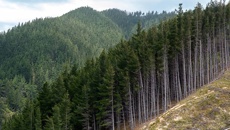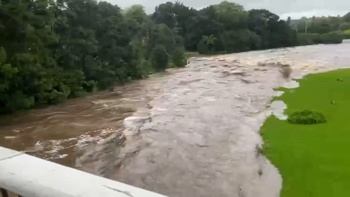It happened in a matter of seconds: a supersonic release of pressure that sent volcanic ash 3.6km skyward and blasted White Island with a hurricane-like current.
Such was the devastating potential of the type of steam-driven event – termed a hydrothermal or phreatic eruption - that unfolded yesterday afternoon, killing up to 13 people.
The volcano
We know White Island as a jagged hunk of rock jutting out of the Pacific Ocean, lying 20km off the coast of Whakatāne.
But what lies under this visible summit is a monster stratovolcano, built of layers of tephra and andesite lava flows, and rising up an extraordinary 1.6km from the ocean floor.
Over its 150,000 years, the volcano has been building toward the sky, with a magma chamber that shoots up within it and breaks off into fingers that form vents at the surface.
Gases dissolved in the magma escape and rise towards the surface where they mix with, and heat the groundwater beneath the crater floor.
At the surface, these gases sting the eyes and hinder breathing: on a given day, 2000 tonnes of carbon dioxide and up to 800 tonnes of sulphur dioxide rise from its bowels.
/arc-anglerfish-syd-prod-nzme.s3.amazonaws.com/public/WXVYFZR7RBEZJGRGNOPS5JNS7A.jpg)
Most of the 2km-wide, 321m-high island is occupied by the main crater, with the crater floor sitting less than 30m above sea level.
A series of eruptions that took place between the mid-1970s and 2001 proved the volcano's most active period in hundreds of years, before a new era kicked off with an eruption in 2012.
While previous eruptions sent ash and plumes as high as 10km – along with lava bombs and blocks into the ocean – yesterday's event was the biggest disaster since 10 miners were killed in a lahar in 1914.
The eruption
White Island's biggest danger is its ability to unleash sudden explosive eruptions at any time.
Writing in The Conversation, University of Auckland volcanologist Professor Shane Cronin put that threat down to its shallow magma, and the interplay of its heat and gases with surface and ground water at the top.
"In these, water is trapped in pores of rocks in a super-heated state. Any external process, such as an earthquake, gas input from below, or even a change in the lake water level can tip this delicate balance and release the pressure on the hot and trapped water," Cronin explained.
"The resulting steam-driven eruption, also called a hydrothermal or phreatic eruption, can happen suddenly and with little to no warning."
The expansion of water into steam was supersonic in speed - and the liquid could expand to 1700 times its original volume, producing catastrophic impacts.
"The expansion energy is enough to shatter solid rock, excavate craters and eject rock fragments and ash out to hundreds of metres away from the vent," Cronin said.
"We know of sites in New Zealand where material has been blasted out over 3km from the vent by such eruptions."
These steam-driven eruptions came with violent ejections of hot blocks and ash, and hurricane-like currents of wet ash and coarse particles that swept out from the explosion vent.
Speaking with RNZ, GNS volcanologist Steve Sherburn likened the sudden depressurisation to that of a soft drink bottle or pulling the cork out of a bottle of champagne.
"And in the case of a situation like today's eruption, it fractures and fragments all the overlying rock, some of it into really fine particles like ash," Sherburn said.
"Some of it could be much, much larger particles - golf ball size, cricket ball size, pumpkin size, you know, it could be really large. Large eruptions can even throw things the size of small cars.
/arc-anglerfish-syd-prod-nzme.s3.amazonaws.com/public/ASPMOYS4HJAXRMNSNNR2WALXVY.jpg)
"Because the eruption has occurred close to - possibly from within the lake - there could be a lot of water projected at the same time so you can get really quite a mixture of material."
Cronin said that, while these eruptions were short-lived, once one happened there was a high chance for further, generally smaller ones as the system re-equilibrated.
"White Island is an acute location for such activity, but it is not the only location in New Zealand where this can happen."
Mt Ruapehu, Mt Tongariro and geothermal areas of the central North Island all had the potential to cause such events.
"We know there have been more than 60 hydrothermal eruptions in the last 100 years in New Zealand. Some of these have caused loss of life."
The monitoring
Cronin said monitoring and warning for hydrothermal eruptions was a "huge challenge".
"We don't normally see these eruptions coming, no matter how much we would like to.
Many systems are already "primed" for such events, but the triggers are poorly understood."
Under the GeoNet-managed NZ Volcanic Alert Level system, ranging from zero to five, the volcano had recently been rated level 2, indicating "moderate to heightened volcanic unrest".
That had been raised in response to increasing amounts of sulphur dioxide gas, along with volcanic tremors – both of which can signal rising magma deep in the volcano.
Yet the actual warning signals of an impending eruption, once one got under way, were likely in the order of seconds to minutes, Cronin said.
"Our only hope for anticipating these events is to track potential vapour and liquid pressure in hydrothermal systems and to learn from their long-term behaviour when they are at a super-critical state," he said.
"Unfortunately there are no simple rules that can be followed and each hydrothermal system is different.
"In this age of technology and instrumental monitoring, it seems irrational that there should be little or no warning for such eruptions.
"The eruption is not caused by magma, but by steam, and this is much harder to track in our current monitoring systems."
Take your Radio, Podcasts and Music with you









